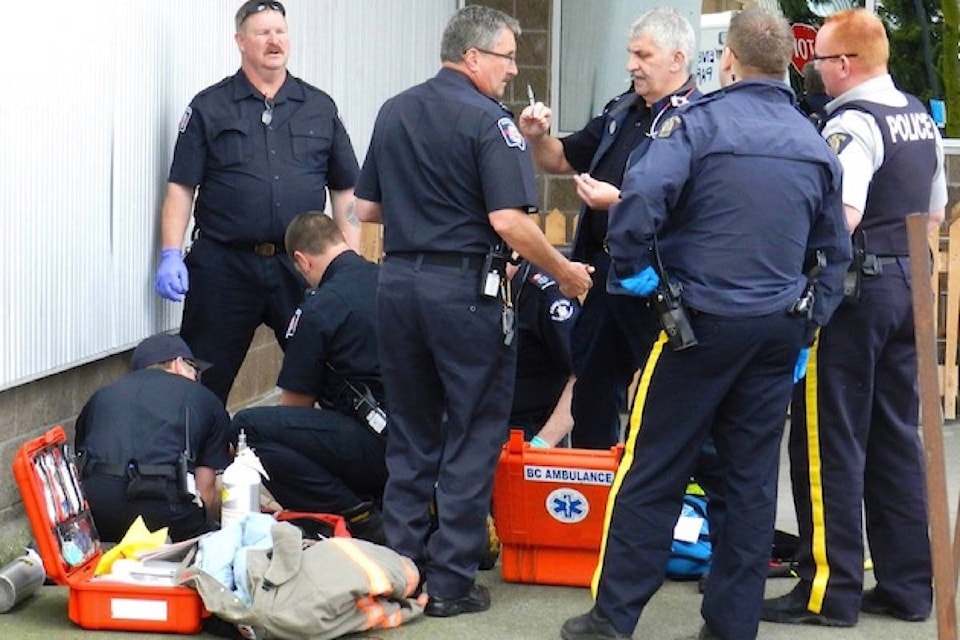As an overdose crisis began taking shape in Denver, Colo., one of the places the city’s leaders looked for answers was north of the border.
Coun. Albus Brooks says he hopped on a plane to Vancouver last year before putting together a recent proposal to open what could become the first legal supervised consumption site in the United States.
“I went out there personally to meet with council members, the chief of police, community members, business folks — I interviewed them all,” he said.
"Denver Health Paramedics, who respond to nearly all 911 medical calls in Denver, use naloxone as many as three times a day." Check this out, @AlbusBrooksD9 ! Thanks as always, @RobValuck! https://t.co/2yaGbFBNLY
— HRAC (@HRAC_Denver) December 21, 2018
Last month, Denver council approved a proposal for a two-year pilot project allowing a safe consumption site, which lets people use drugs under the supervision of staff who are trained in overdose response.
The program must win approval from the state legislature, which is now under Democratic control after the November election. Earlier this year, the Republican-controlled state Senate killed similar legislation.
Other U.S. cities, including San Francisco, Seattle, New York and Philadelphia, have also expressed interest in opening supervised injection sites. California lawmakers passed a measure that would have protected workers and participants in a San Francisco pilot program from state prosecution, but Gov. Jerry Brown vetoed it in September.
Brooks said Denver council reviewed models in hundreds of other jurisdictions and also visited Barcelona. But it took several lessons from Vancouver, including the effectiveness of free drug testing and the importance of working across sectors and with many stakeholders.
He said he was struck by the high number of overdose deaths in Vancouver, which has been the epicentre of the crisis in Canada, but also the general consensus on the importance of harm reduction as part of a continuum of care that has been harder to achieve in the United States.
READ MORE: New in-depth report sheds light on who in BC is dying of drug overdoses
The BC Coroners Service recorded 369 overdose deaths in Vancouver last year, while Denver recorded 163 drug-related deaths, according to Colorado’s vital statistics program.
“Everyone seemed to say that harm reduction models were effective and an important part of an overall strategy,” Brooks said. “That’s not understood in the United States.”
Support hasn’t been universal in Canada either. When Insite opened in Vancouver in 2003, making it the first safe consumption site in North America, some argued it would just enable addicts. And as recently as August, the Progressive Conservative government in Ontario under Premier Doug Ford announced it was halting the opening of new overdose prevention sites pending a review.
But data suggests they have been effective. According to the BC Centre on Substance Use, a systematic review of 75 peer-reviewed journal articles on safe consumption sites found that no overdose-related death was ever reported within a site involved in the studies.
A 2011 study in Vancouver also found a 35 per cent decline in overdose deaths in the area around Insite, the centre said.
While the BC Coroners Service does not collect data on “life-saving” measures, spokesman Andy Watson said he believes significantly more people would have died in the crisis if not for harm reduction services.
“We understand the death toll probably would have tripled, based on information we’ve received from other agencies,” he said.
Insite has been a popular destination for both Canadian and American politicians considering the model, with visitors also coming from nearby Seattle, said Carrie Stefanson, spokeswoman for Vancouver Coastal Health, which co-manages the site with non-profit PHS Community Services Society.
“They come on kind of a fact-finding mission or a tour. We have people coming all the time,” she said.
READ MORE: 2,000 Canadians died of an overdose in first 6 months of the year
Sarah Blyth, who runs the Overdose Prevention Society on the city’s Downtown Eastside, said it can be overwhelming to host so many visitors. There are visits almost every other day from politicians, grassroots organizers, nurses, students and others curious about the model — from as far away as Belgium and France and as close as other B.C. cities.
“It’s a bit too much, to be honest, but at the same time it’s so important because they get to bring back education and what we’re doing to other places,” Blyth said.
“And we get to discuss how it’s helpful and answer questions about how you can do it — how it’s easy and affordable and not hard to do.”
Amy Smart, The Canadian Press
